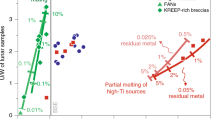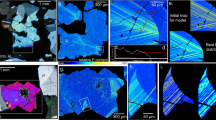Abstract
THE first detailed chemical analysis of lunar rocks1 has renewed interest in the problem of the origin of the Moon. Although many controversies revolve around this question, it is reasonable to begin with the hypothesis that the Moon was originally formed from a cloud of gas and dust approximating the solar or “cosmic” composition and that it underwent the obvious differentiation not only with respect to certain gases but also with respect to more refractory elements. Differentiation could have occurred within the hypothetical solar nebula itself even before separation of the condensed body, through ambipolar diffusion in a mixture of neutral and ionized gases in a magnetic field2 or by differential magnetic forces on solids3. It could also have occurred during condensation and agglomeration into the condensed sphere and later through igneous and metamorphic processes. Discussions of possible differentiation through magmatic processes have already been given by Salisbury4, O'Keefe and Cameron5, Lowman6 and Walter7.
This is a preview of subscription content, access via your institution
Access options
Subscribe to this journal
Receive 51 print issues and online access
$199.00 per year
only $3.90 per issue
Buy this article
- Purchase on Springer Link
- Instant access to full article PDF
Prices may be subject to local taxes which are calculated during checkout
Similar content being viewed by others
References
Lunar Sample Preliminary Examination Team, Science, 165, 1211 (1969); Summary of Apollo 11 Lunar Science Conference, ibid., 167, 449 (1970).
Alfvén, H., On the Origin of the Solar System (Oxford University Press, 1954); Hoyle, F., Quart. J. Roy. Astron. Soc., 1, 28 (1960).
Harris, P. G., and Tozer, D. C., Nature, 215, 1449 (1967).
Salisbury, J. W., Astrophys. J., 134, 126 (1961).
O'Keefe, J. A., and Cameron, W., Icarus, 1, 271 (1962).
Lowman, jun., P. D., Icarus, 1, 35 (1963).
Walter, L. S., Ann. New York Acad. Sci., 123, 470 (1965).
Baldwin, R. B., The Face of the Moon (Univ. Chicago Press, 1949); The Measure of the Moon (Univ. Chicago Press, 1963).
Ahrens, L. H., Geochim. Cosmochim. Acta, 3, 1 (1952).
Jokippi, J. R., Icarus, 3, 248 (1964).
Ahrens, L. H., and Taylor, S. R., Spectrochemical Analysis (Addison-Wesley, Reading, Mass., 1961); Aller, L. H., The Abundance of the Elements (Interscience, New York, 1961).
Goles, G. G., in Handbook of Geochemistry, 6 (edit. by Wedepohl, K. H.) (Springer, Berlin, 1969).
Nockolds, S. R., Bull. Geol Soc. Amer., 65, 1007 (1954).
Ringwood, A. E., Rev. Geophys., 4, 113 (1966).
Wager, L. R., and Deer, W. A., Medd. om Grønland, 105, No. 4 (1939).
Hess, H. H., Geol. Soc. Amer. Memoir 80 (1960).
Muan, A., and Osborn, E. F., J. Amer. Ceramic Soc., 39, 121 (1956).
Birch, F., Schairer, J. F., and Spicer, H. C., Handbook of Physical Constants, Geol. Soc. Amer. Spec. Paper 36 (1942).
Author information
Authors and Affiliations
Rights and permissions
About this article
Cite this article
MUELLER, R. Apollo II Evidence for the Differentiation of Lunar Materials. Nature 226, 925–927 (1970). https://doi.org/10.1038/226925a0
Received:
Revised:
Issue Date:
DOI: https://doi.org/10.1038/226925a0
Comments
By submitting a comment you agree to abide by our Terms and Community Guidelines. If you find something abusive or that does not comply with our terms or guidelines please flag it as inappropriate.



